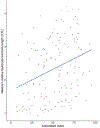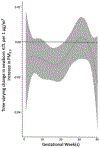Prenatal particulate air pollution and newborn telomere length: Effect modification by maternal antioxidant intakes and infant sex
- PMID: 32474316
- PMCID: PMC7844769
- DOI: 10.1016/j.envres.2020.109707
Prenatal particulate air pollution and newborn telomere length: Effect modification by maternal antioxidant intakes and infant sex
Abstract
Background: Evidence links gestational exposure to particulate matter with an aerodynamic diameter of less than 2.5 μm (PM2.5) with changes in leukocyte telomere length in cord blood with some studies showing sex-specific effects. PM2.5 exposure in utero increases oxidative stress, which can impact telomere biology. Thus, maternal antioxidant intakes may also modify the particulate air pollution effects.
Methods: We examined associations among prenatal PM2.5 exposure and newborn relative leukocyte telomere length (rLTL), and the modifying effects of maternal antioxidant intake and infant sex. We estimated daily PM2.5 exposures over gestation using a validated spatiotemporally resolved satellite-based model. Maternal dietary and supplemental antioxidant intakes over the prior three months were ascertained during the second trimester using the modified Block98 food frequency questionnaire; high and low antioxidant intakes were categorized based on a median split. We employed Bayesian distributed lag interaction models (BDLIMs) to identify both sensitive windows of exposure and cumulative effect estimates for prenatal PM2.5 exposure on newborn rLTL, and to examine effect modification by maternal antioxidant intakes. A 3-way interaction between PM2.5, maternal antioxidant intake and infant sex was also explored.
Results: For the main effect of PM2.5, BDLIMs identified a sensitive window at 12-20 weeks gestation for the association between increased prenatal PM2.5 exposure and shorter newborn rLTL and a cumulative effect of PM2.5 over gestation on newborn telomere length [cumulative effect estimate (CEE) = -0.29 (95% CI -0.49 to -0.10) per 1μg/m3 increase in PM2.5]. In models examining maternal antioxidant intake effects, BDLIMs found that children born to mothers reporting low antioxidant intakes were most vulnerable [CEE of low maternal antioxidant intake = -0.31 (95% CI -0.55 to -0.06) vs high maternal antioxidant intake = -0.07 (95% CI -0.34 to 0.17) per 1μg/m3 increase in PM2.5]. In exploratory models examining effect modification by both maternal antioxidant intakes and infant sex, the cumulative effect remained significant only in boys whose mothers reported low antioxidant intakes [CEE = -0.38 (95% CI -0.80 to -0.004)]; no sensitive windows were identified in any group.
Conclusions: Prenatal PM2.5 exposure in mid-gestation was associated with reduced infant telomere length. Higher maternal antioxidant intakes mitigated these effects.
Keywords: Antioxidant intakes; Particulate air pollution; Prenatal; Sex-specific effects; Telomere length.
Copyright © 2020 Elsevier Inc. All rights reserved.
Conflict of interest statement
Declaration of competing interest The authors declare that they have no known competing financial interests or personal relationships that could have appeared to influence the work reported in this paper.
Figures





Similar articles
-
Association between prenatal particulate air pollution exposure and telomere length in cord blood: Effect modification by fetal sex.Environ Res. 2019 May;172:495-501. doi: 10.1016/j.envres.2019.03.003. Epub 2019 Mar 2. Environ Res. 2019. PMID: 30852452 Free PMC article.
-
Prenatal fine particulate exposure and early childhood asthma: Effect of maternal stress and fetal sex.J Allergy Clin Immunol. 2018 May;141(5):1880-1886. doi: 10.1016/j.jaci.2017.07.017. Epub 2017 Aug 8. J Allergy Clin Immunol. 2018. PMID: 28801196 Free PMC article.
-
Prenatal Air Pollution and Newborns' Predisposition to Accelerated Biological Aging.JAMA Pediatr. 2017 Dec 1;171(12):1160-1167. doi: 10.1001/jamapediatrics.2017.3024. JAMA Pediatr. 2017. PMID: 29049509 Free PMC article.
-
Maternal exposure to air pollution and risk of autism in children: A systematic review and meta-analysis.Environ Pollut. 2020 Jan;256:113307. doi: 10.1016/j.envpol.2019.113307. Epub 2019 Sep 26. Environ Pollut. 2020. PMID: 31733973
-
Ambient air pollution exposure and telomere length: a systematic review and meta-analysis.Public Health. 2023 Feb;215:42-55. doi: 10.1016/j.puhe.2022.11.022. Epub 2023 Jan 13. Public Health. 2023. PMID: 36642039
Cited by
-
Association between Prenatal Particulate Matter Exposure and Neuropsychiatric Disorders Development.Biomol Ther (Seoul). 2025 Jul 1;33(4):557-571. doi: 10.4062/biomolther.2025.031. Epub 2025 Jun 11. Biomol Ther (Seoul). 2025. PMID: 40494647 Free PMC article. Review.
-
The association of prenatal ambient air pollution with placental epigenetic gestational age at birth.Environ Epidemiol. 2025 May 5;9(3):e384. doi: 10.1097/EE9.0000000000000384. eCollection 2025 Jun. Environ Epidemiol. 2025. PMID: 40331055 Free PMC article.
-
Prenatal Ambient Ultrafine Particle Exposure and Childhood Asthma in the Northeastern United States.Am J Respir Crit Care Med. 2021 Oct 1;204(7):788-796. doi: 10.1164/rccm.202010-3743OC. Am J Respir Crit Care Med. 2021. PMID: 34018915 Free PMC article.
-
Effect of Particulate Matter 2.5 on Fetal Growth in Male and Preterm Infants through Oxidative Stress.Antioxidants (Basel). 2023 Oct 26;12(11):1916. doi: 10.3390/antiox12111916. Antioxidants (Basel). 2023. PMID: 38001768 Free PMC article.
-
Integrating Environment and Aging Research: Opportunities for Synergy and Acceleration.Front Aging Neurosci. 2022 Feb 21;14:824921. doi: 10.3389/fnagi.2022.824921. eCollection 2022. Front Aging Neurosci. 2022. PMID: 35264945 Free PMC article. Review.
References
-
- Block G, Hartman AM, Dresser CM, Carroll MD, Gannon J, Gardner L. 1986. A data-based approach to diet questionnaire design and testing. Am J Epidemiol 124:453–469. - PubMed
-
- Block G 2001. Invited commentary: Another perspective on food frequency questionnaires. Am J Epidemiol 154:1103–1104; discussion 1105-1106. - PubMed
Publication types
MeSH terms
Substances
Grants and funding
LinkOut - more resources
Full Text Sources
Medical

